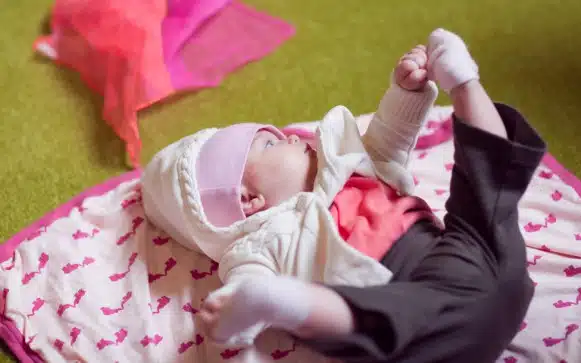If movement is one of the most important learning aspects of child’s young life, then why are we as parents constantly telling our children to sit still?
“He’s such a good baby. He’s so easy. I barely ever hear him make a sound.” These comments are often heard between parents and caregivers. They are also indicative of society’s inclination to restrict — we are taught from a young age to “sit still, to pay attention and to focus on the task at hand.”
I decided not to sign my daughter up for a second session of music when she was a baby because she refused to pay attention and sit in the circle. She was always climbing the walls. In my frustration, it did not dawn on me that her very natural movement, fueled by a desire to explore, was a baby brain development booster — an important aspect of her cognitive development!
Now as a teacher, one of the first instructions I give parents in my music class is “to let their children go.”
Now that she has discovered movement, it is important that we don’t inhibit her or try to wrestle her back into the circle.
Neuroscientists share that the child who explores the classroom is truly stimulating his or her brain development and growth.
- As parents, we tend to think that a baby’s brain is genetically pre-wired. However, neuroscientists now believe that early physical movement experiences are crucial to the neural stimulation needed for baby brain development (Carl Gabbard, 1998).
- It is a child’s activity level and active playtime that determines his or her ultimate brain development and the extent of adult capabilities (Carla Hannaford, 2005).
- According to Katie Rule, Physical Therapist at Lurie Children’s Hospital, spending too much time in car seats, high chair and bouncy seats, can have serious consequences on a child’s cognitive and gross motor development.
Babies are meant to move.
Neuroscientist Carla Hannaford, author of Smart Moves: Why Learning Is Not All in Your Head, explains that beginning in infancy, physical movement plays a vital role in the creation of the nerve cell networks that are at the core of learning.
- An infant’s brain is full of brain cells that are making connections, very much so during the first three years of life. If these brain cell connections are made repeatedly, they become permanent, but if they are not performed repeatedly, they are lost.
I witness daily the relationship between a baby’s gross motor development and the resultant learning. The more children move, the more information they are gathering about the their environment and themselves.
- Even by simply crawling the classroom, a baby is gathering insight — touch exercises tactile and kinesthetic skills, and any sort of reaching, pulling and eventually locomotion contributes to muscle development and spatial awareness.
Whenever a baby moves or plays, there is the potential for learning to occur.
Of course, an infant’s movements are limited, but with even the simplest of activities, your baby’s capability to learn is boundless.
Here are a couple of ideas for feeling safe, comfortable and nurturing as your child moves around both inside and out, enabling healthy baby brain development:
(1) Blow Bubbles: Baby will turn to watch them! Between 6-12 months, you can encourage your baby to reach for bubbles or any other toy that interests her. This basic activity promotes hand-eye coordination.
(2) Rolling Over: While a baby’s movements like rolling over can be involuntary or reflexive, this voluntary movement typically takes place around 6 months of age. A little incentive will do wonders to help your baby perform this task. When she is on her back, hold a favorite toy over her. Once you have her attention, move the toy from side to side, encouraging your child to reach for it.
(3) Crossing the mid-line: We encourage baby to reach across her body to retrieve such alluring objects as lighted balls, brightly colored scarves, etc.
- Later when they reach the Crawlers Music Class, we use our colorful props and puppets to entice children to apply their new crawling skill across the room.
(4) Finger-plays: We use lots of different finger-plays such as “Pat-a-Cake” because they work so well to encourage clapping, tapping, kicking and reaching. Sing traditional songs such as the “The Itsy Bitsy Spider” and “Twinkle, Twinkle Little Star.”
(5) Manipulative Skills: By placing a toy, blanket or stuffed animal close to your baby’s feet, she will be encouraged to kick it. When your baby is able to stand up on her own, place an empty basket near them and encourage them to put toys into it. “Clean Up Time” is typically a favorite activity between 12-18 months, and it is also a strong way to strengthen manipulative skills.
(6) Spatial Awareness: We use parachutes and tunnels in class to work on the understanding of spatial awareness, which involves the ability to be aware of oneself within a space and to feel coordinated. It is a complex cognitive skill that children learn at an early age.
- You can help your child by placing a toy just out of her reach. She will begin to understand the amount of muscle strength it will take to reach that toy. As she works on spatial awareness, your child will become more and more familiar with how her limbs work and how to use them.
(7) Cruising: Babies typically start to pull up on things between 6-12 months. Create a safe environment and encourage them to do this, as it will help them eventually to walk unassisted. Holding an object or pushing things supports motor development as well as cause and effect understanding.
- An excessive amount of push toy use can delay a child from walking on her own and may cause her to walk on tiptoes.
- You can help your child to walk on her own by gently placing your hands loosely around the waist or under the arms to assist her.
Embrace the period of early movement with your child and encourage them to play, move and explore their surroundings. By celebrating each move, you very well could be setting her up to become a “Mover and Shaker,” and for success later on in life.
- The Bright Move: This post is a part of a collection of blogs leading into Fall 2014. The thoughtful, bright moves Bubbles Academy takes in the classroom and recommends for at-home, feature explorative play & arts based activities — encouraging healthy physical, cognitive and social development for your child. Like this post? Share with the hashtag #thebrightmove

Kim Schiefelbein
Kim Schiefelbein is the Senior Director of Music and Community Programming at Bubbles Academy. A certified fitness instructor, Kim also leads the Stroller Fitness program.
